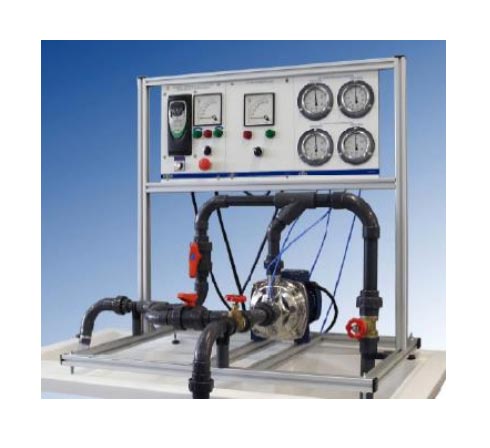TRAINING OBJECTIVES
• Start up of a pump, analysis and study of related aspects.
• Pump priming.
• Checking the direction of rotation
• Over current produced in the pump motor.
• Study and obtaining of the characteristic curves of a pump: Height – flow (H-Q) / Power – flow (P-Q) / Performance – flow (ƞ-Q)
• Study of cavitation and obtaining the characteristic curves of NPSH required flow.
• Study of different ways to regulate a turbo pump.
• Variation of pump rotational speed and obtaining new curves.
• Changing the operating point by varying the pumping installation
• Adjusting the discharge valve
• Analysis of similar pumps running in group – Characteristic curves in-series operation: Height – flow ( H- Q ) / Power – Flow (P- Q ) / Performance – Flow (ƞ – Q )
– Characteristic curves parallel operation. Height – flow (H- Q) / Power – Flow (P- Q) / Performance – Flow (ƞ – Q)
• Analysis of different pumps running in group
– Characteristic curves in-series operation. Height – flow (H- Q) / Power – Flow (P- Q) / Performance – Flow (ƞ – Q)
– Characteristic curves parallel operation. Height – flow (H- Q) / Power – Flow (P- Q) / Performance – Flow (ƞ – Q)
TECHNICAL DATA
Diameters
• Suction piping
– Inner Ø = 27.2mm
– Outer Ø = 32mm
• Discharge piping
– Inner Ø = 34mm
– Outer Ø = 40mm
Manometers:
• Bourdon type with glycerin from -10.33m to +35M WC (x3).
• Bourdon type with glycerin from -10m to +70 M WC
Pump features:
• Maximum manometric head: 23m M WC
• Maximum flow rate: 20/160 l/min
• H21 / 10m M WC
• H max 23m M WC
• H min 10m M WC
• Power consumption: 750W (1hp)
• Motor speed: 2,900rpm
Power meter:
• Power meter with range: 0-1,200W
CENTRIFUGAL PUMP – MODULE
The module has been designed to work with the hydraulic bench DL DKL014. It is mounted on an aluminum frame.
It is supplied with a number of pipes and valves that allows the coupling of the module and the pump of the hydraulic bench in-series or in parallel.
The system has a frequency converter to control the pump rotation speed.
It also includes two power meters for the obtaining of the consumed power of the two pumps.
Besides the study of the characteristics of centrifugal pumps, it is possible to approach the operation and function of the main factors affecting the pump efficiency.
















